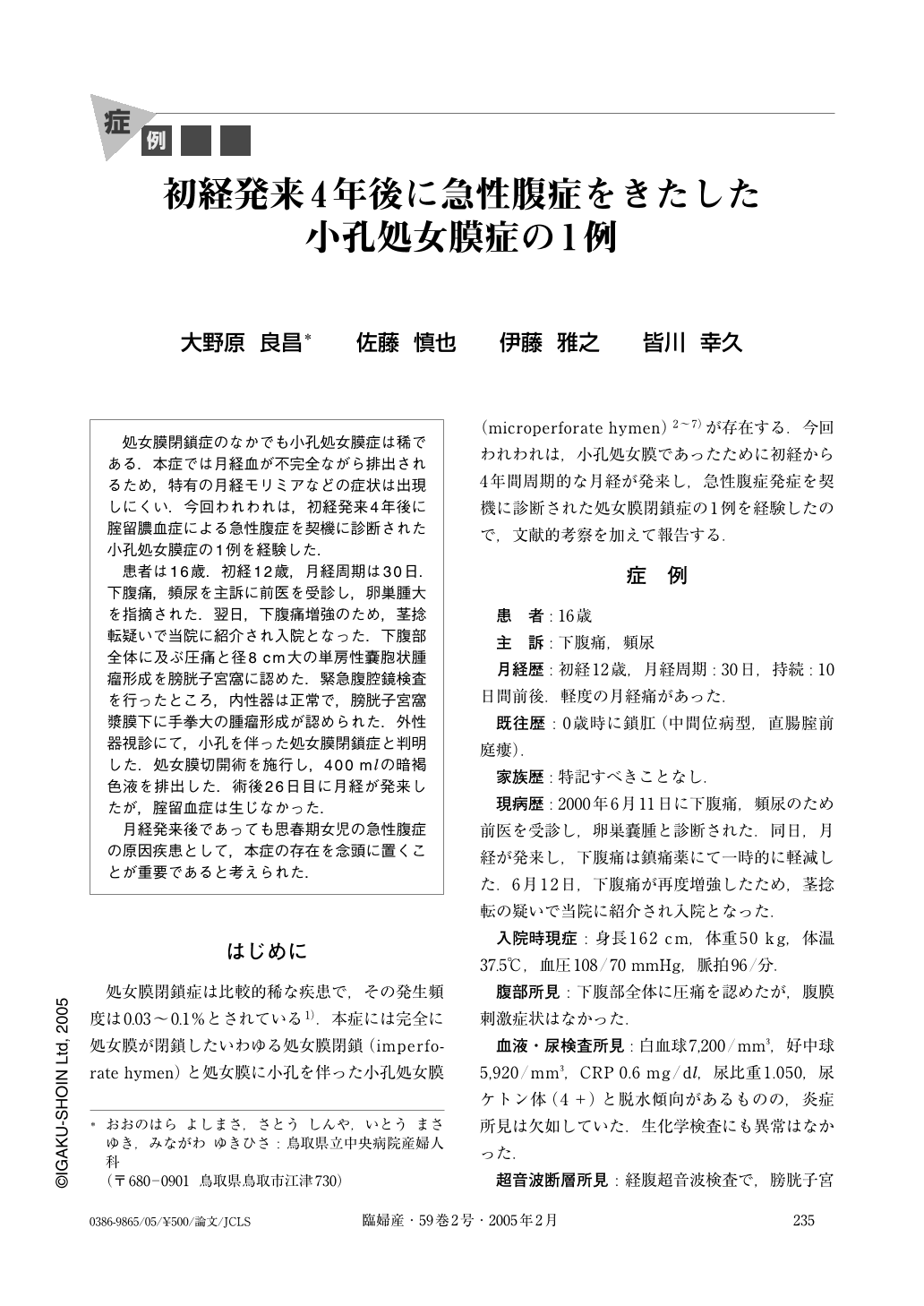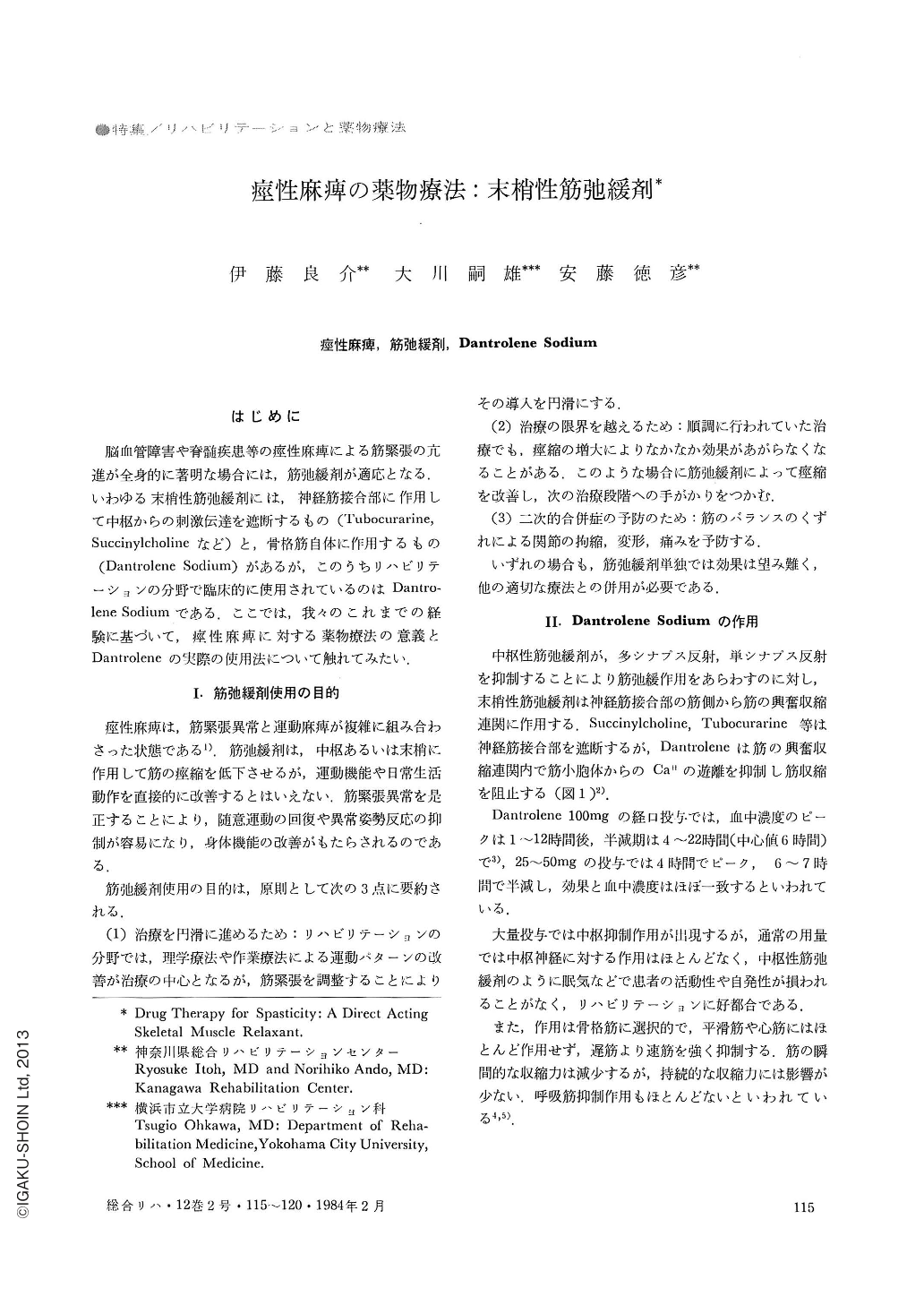- 著者
- 岡本 芳晴 大﨑 智弘 東 和生 伊藤 典彦 柄 武志 今川 智敬 菅波 晃子 田村 裕
- 出版者
- Japan Society for Laser Surgery and Medicine
- 雑誌
- 日本レーザー医学会誌 (ISSN:02886200)
- 巻号頁・発行日
- vol.35, no.1, pp.46-50, 2014-05-15 (Released:2015-09-09)
- 参考文献数
- 9
- 被引用文献数
- 1
我々はインドシアニングリーン(ICG)をリン脂質成分に結合させたICG修飾リポソーム(ICG-lipo)を開発した.今回は深部腫瘍15例に対し,ICG-lipo(抗がん剤等内包)を点滴投与後,近赤外線光源装置または半導体レーザーを用いて患部に20-60分間光照射した.照射間隔は毎日~週3日で実施した.Response Evaluation Criteria in Solid Tumors (RECIST)に基づく判定結果はCR:1 例,PR:8例,SD:5例,PD:1例であった.PR,SD症例は全例QOLの改善がみられた.15例いずれも重篤な副作用は確認されなかった.
1 0 0 0 OA 追従運転時における車間時間の違いによる脇見時間への影響と追突警報の効果
- 著者
- 安部 原也 伊藤 誠 山村 智弘
- 出版者
- The Society of Instrument and Control Engineers
- 雑誌
- 計測自動制御学会論文集 (ISSN:04534654)
- 巻号頁・発行日
- vol.48, no.11, pp.688-697, 2012 (Released:2012-11-29)
- 参考文献数
- 10
In order to clarify the effect of different time headways and lead car's decelerations on visual distraction and its impact on collision risk during car-following a driving simulator study was conducted. Moreover the experimental investigation considered system effectiveness of a forward collision warning system as for decreased collision risk. Results showed that compared to short time headway, long time headway induced long duration time of visual distraction during car-following. This effect was significant when a lead car decreased its speed mildly. Collision risk due to lead car's deceleration was low for long time headway during car-following compared to short time headway even thought visual distraction was induced. However there was a possibility that long time headway led to long duration time of visual distraction resulting in increased collision risk. In case of the alarm trigger logic used in this study, alarms effectiveness for decreasing collision risk was proven because early alarms were given for short time headway. It can be said that longer headway time does not always guarantee decreased collision risk.
1 0 0 0 IR 七田式脳トレーニング法による健常高齢者の認知機能への影響
- 著者
- 伊藤 智子 加藤 真紀 佐藤 公子 山下 一也 Tomoko ITO Maki KATO Kimiko SATO Kazuya YAMASHITA
- 出版者
- 島根県立大学出雲キャンパス
- 雑誌
- 島根県立大学出雲キャンパス紀要 = Bulletin of the University of Shimane Izumo Campus (ISSN:2187199X)
- 巻号頁・発行日
- vol.12, pp.11-17, 2017
【目的】認知症予防としての、脳トレの効果を検討するため、七田式いきいき脳開発プログラムの効果検証を試みた。【方法】65-90歳の健常高齢者70名を七田式脳トレ群、対照群の2群に分け、6ヶ月間実施した。介入前後に、MMSE、HDS-R、FAB、CADi、やる気指数、うつ指標の測定を行った。群別に各調査項目、介入前後の差を解析した。また介入前後の認知機能検査値とSDS、やる気指数の相関を解析した。【結果】脳トレ群の介入前後のFAB 得点において有意差が見られた。脳トレ群においてFAB とHDS-R 値がSDS 指数と正の相関があった。【考察】6ヶ月の七田式脳トレ継続による、前頭葉機能の活性化が示唆された。
1 0 0 0 OA 階段を一ステップ一段と一ステップ二段で昇る場合の身体的負荷の違い
- 著者
- 石原 健吾 髙石 鉄雄 伊藤 廉子 澤田 祐子 辻 沙奈恵 森友 理絵 脊山 洋右
- 出版者
- 一般社団法人 日本家政学会
- 雑誌
- 日本家政学会誌 (ISSN:09135227)
- 巻号頁・発行日
- vol.63, no.2, pp.71-77, 2012-02-15 (Released:2013-09-30)
- 参考文献数
- 8
This study compares the physiological work load between two ascending patterns, single-step (SS) and double-step (DS), when climbing a public staircase at the two different climbing rates, controlled speed (105steps/min) and free speed. The SS pattern involved climbing one step at a time, while the DS pattern involved climbing two steps in a single stride. Thirteen female subjects climbed a typical 7-storey building, giving a total of 168 steps and vertical movement of 27.7 m. The results for perceived exertion (RPE), blood lactate level, oxygen consumption and muscle EMG activity were significantly higher (p < 0.05) with the DS than SS pattern at a controlled speed. The results also showed that the ascending speed, heart rate, blood lactate level, respiratory quotient (RQ) and RPE were significantly higher (p < 0.05) with the DS than SS pattern at a free speed. These results clearly indicate the higher physical workload involved with the DS than SS pattern at both free and controlled speeds.
1 0 0 0 『床下の小人たち』に見られる「英国らしさ」
- 著者
- 伊藤 紀美江
- 出版者
- 平安女学院大学
- 雑誌
- 保育研究 (ISSN:03866246)
- 巻号頁・発行日
- no.43, pp.19-24, 2015-03
『床下の小人たち』というタイトルで1956年林容吉によって日本語に翻訳されたメアリー・ノートン(1903-1992)のThe Borrowers(1952)は、60年近くに亘って日本の子どもたちに読み継がれている。しかし、どんなに優れた翻訳作品でも、書かれた国の文化的背景を原作とまったく同じように表現するには限界があり、また翻訳者は翻訳で作品を知ることになる読者への配慮が必要である。 この小論では、The Borrowersを原書で読むことで初めて見えてくる、英国独自の文化やその面白さについて、登場人物の名前の持つ意味、登場人物の英国人らしい振る舞い、舞台となる屋敷や主人公一家が暮らす床下の家のインテリア、英国社会に深く根付く階級制度などを中心に言及sるとともに、林氏の翻訳の素晴らしさについても紹介する。
1 0 0 0 油量の違いが揚げ物の揚がり具合に及ぼす影響
- 著者
- 露口 小百合 明神 千穂 村上 恵 和田 珠子 伊藤 知子 今義 潤 江口 智美 久保 加織 高村 仁知 中平 真由巳 原 知子 水野 千恵
- 出版者
- 日本調理科学会
- 雑誌
- 日本調理科学会大会研究発表要旨集
- 巻号頁・発行日
- vol.24, 2012
<b>【目的】</b>揚げる・炒める分科会ではこれまで揚げ種重量の10倍程度の油を用いた一般的な揚げ方法での様々な研究を行なってきた。しかし、最近では環境問題や健康への配慮から少量の油で揚げる「シャロウフライ」と呼ばれる方法が注目されている。そこで今回は揚げ種が浸る程度の少ない油量で揚げた場合の揚がり具合について検討した。<br> <b>【方法】</b>試料として豚カツ(業務用冷凍豚一口カツ)およびサツマイモ、揚げ油はキャノーラ油を用いた。油の量は「ディープ」(油の深さが揚げ種の厚さの2倍)、「シャロウ1」(同1倍)、「シャロウ1/2」(同1/2倍)とした。温度調節付きガスコンロと26cm径のフライパンを用い、豚カツは180℃、5分間、サツマイモは160℃、6分間揚げた。揚げ操作中に揚げ種の中心温度と油温の変化を測定し、揚げ操作後の重量変化より吸油率と脱水率を算出した。官能評価はパネル6~8名で、評点法(外観、油臭さ、におい、味、揚がり具合、テクスチャー、総合)と順位法で行った。<br> <b>【結果】</b>脱水率は、豚カツ、サツマイモともに「シャロウ1/2」で低かった。吸油率は、豚カツでは油量による差はみられなかった。中心温度は「シャロウ1/2」では温度上昇が遅かった。官能評価の評点法は、豚カツ、サツマイモともに外観、におい、揚がり具合、テクスチャーおよび総合において「シャロウ1/2」が有意に低い評価であった。順位法では、豚カツは、「ディープ」、「シャロウ1」、「シャロウ1/2」の順に好まれた。サツマイモの「シャロウ1/2」では仕上がりが不均一で水っぽく感じられ、脱水率の結果と一致していた。以上の結果から、油量の違いは揚がり具合に影響を及ぼすことが明らかになった。
1 0 0 0 シャロウフライの最適な揚げ条件と問題点
- 著者
- 中平 真由巳 水野 千恵 明神 千穂 村上 恵 和田 珠子 安藤 真美 伊藤 知子 今義 潤 江口 智美 久保 加織 高村 仁知 露口 小百合 原 知子
- 出版者
- 日本調理科学会
- 雑誌
- 日本調理科学会大会研究発表要旨集
- 巻号頁・発行日
- vol.26, 2014
<b>【目的】</b>近年、簡便な揚げ調理として、少量の油で揚げる「シャロウフライ」が注目されている。前回、「シャロウフライ」は通常の揚げ調理に比べて、官能評価が低いことを報告した。しかし、これは官能評価に影響を及ぼす要因である脱水率が統一されていない条件下であった。そこで今回は、脱水率を統一して「シャロウフライ」の再評価を実施した。<br><b>【方法】</b>試料は豚カツ(業務用冷凍豚一口カツ)、揚げ油はキャノーラ油を用いた。油量は、通常の揚げ調理である揚げ種の厚さの2倍の深さ(D)、厚さの1倍(S1)、および厚さの1/2倍(S1/2)とした。温度調節付ガスコンロを用いて180℃で揚げ調理を行い、揚げ種の中心温度と油温の変化を測定した。揚げ油の物理化学的性状値として、酸価、カルボニル価、粘度、極性化合物量、および色を測定した。揚げ種について脱水率を算出し、分科会のメンバーをパネル(n=18)として官能評価を評点法(外観、油臭さ、におい、味、揚がり具合、テクスチャー、および総合)により実施した。<br><b>【結果】</b>通常調理(D、揚げ時間5分)と同じ脱水率を得るために、S1は6分、S1/2は8分を要した。官能評価の評点(外観、におい、揚がり具合、テクスチャーおよび総合)において、S1とS1/2は揚げ時間の延長により、有意に高い評価が得られた。揚げ油の化学的性状値は、カルボニル価、極性化合物量、および色においてS1/2では揚げ時間の延長とともに上昇した。以上の結果から、シャロウフライは的確な揚げ時間の延長と揚げ作業の継続により、Dと同等の風味評価を確保できることが明らかとなった。一方、シャロウフライでは、使用油の劣化は大で、油の劣化に繋がることが明確になった。
1 0 0 0 OA 山口県における淡水産ハゼ科魚類の分布
1 0 0 0 IR 過敏性腸症候群に対する認知・行動療法の展望
- 著者
- 伊藤 雅隆 武藤 崇 Masataka Ito Takashi Muto イトウ マサタカ ムトウ タカシ
- 出版者
- 心理臨床科学編集委員会
- 雑誌
- 心理臨床科学 = Doshisha Clinical Psychology : therapy and research (ISSN:21864934)
- 巻号頁・発行日
- vol.5, no.1, pp.83-94, 2015-12-15
本稿の目的は,過敏性腸症候群(IBS:Irritable Bowel Syndrome)に対しての認知・行動療法(CBT:Cognitive Behavior Therapy)について展望を行うことであった。有病率が約11%とされるIBSは機能性の消化器障害で,患者の多くがうつ病や不安症などを併発している。薬物療法で軽快しない事例などに,心理療法が適用され,その中でもCBTがその有効性を示している。IBSに対するCBTプログラムについて4種類に分類した。(a)認知療法を用いたもの,(b)ストレスマネジメントを中心にしたもの,(c)腸症状への不安を中心にしたもの,(d)マインドフルネスを用いたものに分類され,それぞれの特徴が示された。今後の課題として,併発症状やQOL改善を見据えた治療プログラムが必要であること,IBS の心理面の基礎的な研究が少ないこと,本邦での治療研究が必要であることが指摘された。研究動向
1 0 0 0 わが国の2コホート研究間における脳卒中後職場復帰の時間経過の比較
- 著者
- 佐伯 覚 松嶋 康之 加藤 徳明 伊藤 英明 白石 純一郎
- 出版者
- 学校法人 産業医科大学
- 雑誌
- 産業医大誌 (ISSN:0387821X)
- 巻号頁・発行日
- vol.38, no.4, pp.311-315, 2016
- 被引用文献数
- 8
<p>わが国の脳卒中リハビリテーションの状況は,近年,個別治療手技および診療システムの劇的な変化がみられた.すなわち,虚血性脳卒中発症率の増加,静脈注射用組織プラスミノーゲンアクチベーターの使用,病院の機能分化,回復期リハビリテーション病棟の導入,介護保険制度である.しかしながら,これらの変化が脳卒中後の職場復帰(復職)の経過に影響を与えているのかどうかは不明である.本研究では,20年以上隔てられて実施された2つのコホート研究-脳卒中後の復職の経過分析-を比較した.両研究は20年以上離れているが,初発脳卒中患者の累積復職率は両研究でほぼ同様であった.この結果は,脳卒中リハビリテーションの進歩が復職に大きな影響を与えず,むしろ傷病手当金などの社会保障システムが復職に大きな影響を及ぼすことを示唆している.</p>
1 0 0 0 OA 赤丸料の適応病態に関する一考察
- 著者
- 伊藤 隆 寺澤 捷年 桧山 幸孝 三潴 忠道 土佐 寛順 今田屋 章
- 出版者
- The Japan Society for Oriental Medicine
- 雑誌
- 日本東洋医学雑誌 (ISSN:02874857)
- 巻号頁・発行日
- vol.37, no.3, pp.199-206, 1987-01-20 (Released:2010-03-12)
- 参考文献数
- 17
- 被引用文献数
- 4 1
金匱要略所載の赤丸を料として, 80症例 (延87例) に投与した。赤丸の処方構成は茯苓, 烏頭, 細辛に桂枝または半夏を加えるとされている。その有効例, 無効例の解析を行ったところ, 桂枝の加わった赤丸料により高い有効性が得られた。赤丸料は“表”に主座をもつ病変に比較的有効であるが, 有効率を高めるためには鳥頭を一日2g以上用いることが必要であることが示唆された。脈候・腹候に本方に特徴的な所見は得られなかったが, 電気温鍼法による負荷試験で20分以上を示すことが必要条件である。また自覚的には身体の寒さを異常に訴えるもの, 易疲労を伴うものに適応となるものが多い傾向が示された。金匱要略には「寒気厥逆」とのみその適応病態が記されているが, 今回の研究により本方の適応病態がより具体化されたものと考える。
1 0 0 0 OA 青い〈嫉妬〉 : 『イコノロジーア』と一五-一六世紀の色彩象徴論
- 著者
- 伊藤 亜紀
- 出版者
- 美学会
- 雑誌
- 美学 (ISSN:05200962)
- 巻号頁・発行日
- vol.55, no.3, pp.1-13, 2004-12-31 (Released:2017-05-22)
Cesare Ripa, in his Iconologia (first edition: 1593), defines Gelosia (Jealousy) as 'Donna con una veste di torchino a onde' (a woman dressed in the turquoise blue of waves). The 16th century Treatises on color symbolism of Fulvio Pellegrino Morato, Lodovico Dolce and so on, positively describe the relation of turchino to Jealousy. However, Le Blason des Couleurs (1435-58) of Sicille, had already stated: 'Le bleu signifie jalousie' (Blue signifies Jealousy), and consequently it is obvious that this symbolism existed in an earlier period in France. In 14th century France it was known that bleu signifies both the good and bad sides of love: Fidelity and Infidelity. And we can believe that also Jealousy, like Infidelity, which is considered to be an enemy of love, or a negative by-product of love, combined easily with bleu. Accordingly the idea of ambiguity of bleu came to Italy through French Literature and so on, and was introduced in the 16th century Treatises on color symbolism, and was finally applied to Gelosia of Ripa.
1 0 0 0 OA カイコ濃核病ウイルスと抵抗性遺伝子群
- 著者
- 伊藤 克彦 門野 敬子
- 出版者
- 社団法人 日本蚕糸学会
- 雑誌
- 蚕糸・昆虫バイオテック (ISSN:18810551)
- 巻号頁・発行日
- vol.76, no.3, pp.3_197-3_205, 2007 (Released:2016-04-13)
- 参考文献数
- 44
1 0 0 0 OA 月経後期の片頭痛に十全大補湯が有効であった9症例の検討
- 著者
- 木村 容子 佐藤 弘 伊藤 隆
- 出版者
- 一般社団法人 日本東洋医学会
- 雑誌
- 日本東洋医学雑誌 (ISSN:02874857)
- 巻号頁・発行日
- vol.69, no.1, pp.22-28, 2018 (Released:2018-07-04)
- 参考文献数
- 20
片頭痛の治療では発作時の痛みだけでなく,ストレス,月経,疲れなど誘発・増悪因子の治療も重要である。陰虚証で過度の疲労や寝不足,更年期症状などが重なると気血両虚を背景として月経後期に頭痛が起こるがある。全体の経血量が多くない場合でも月経2-3日目で比較的多く出血した後,月経4-5日目から起こる頭痛に補気補血作用のある十全大補湯が有効な症例を経験した。症例1から4を具体的に提示する。症例1では日々の服用を温経湯から十全大補湯に変更し,他の症例では月経期間の7日間のみ,十全大補湯を当帰四逆加呉茱萸生姜湯に追加(症例2)あるいは当帰芍薬散から十全大補湯に変更(症例3-4)した。十全大補湯で月経後期の頭痛が改善した9症例では,冷え(9/9例),易疲労感(9/9例)や乾燥症状(7/9例)を認めた。月経後期の片頭痛には十全大補湯が有効な場合があるが,投与量や服用期間は気血両虚の程度で調整する必要がある。
1 0 0 0 初経発来4年後に急性腹症をきたした小孔処女膜症の1例
1 0 0 0 痙性麻痺の薬物療法:末梢性筋弛緩剤
はじめに 脳血管障害や脊髄疾患等の痙性麻痺による筋緊張の亢進が全身的に著明な場合は,筋弛緩剤が適応となる.いわゆる末梢性筋弛緩剤には,神経筋接合部に作用して中枢からの刺激伝達を遮断するもの(Tubocurarine,Succinylcholineなど)と,骨格筋自体に作用するもの(Dantrolene Sodium)があるが,このうちリハビリテーションの分野で臨床的に使用されているのはDantrolene Sodiumである.ここでは,我々のこれまでの経験に基づいて,痙性麻痺に対する薬物療法の意義とDantroleneの実際の使用法について触れてみたい.
- 著者
- 岡本 裕之 太田 誠一 川守田 龍 坂本 昌隆 中村 哲志 西岡 史絵 株木 重人 正井 範尚 水野 統文 古谷 智久 山本 鋭二郎 飯島 康太郎 伊藤 芳紀 勝田 昭一 黒岡 将彦 川村 愼二 橘 英伸 遠山 尚紀 中村 勝 峯村 俊行 中山 優子
- 出版者
- 公益社団法人 日本医学物理学会
- 雑誌
- 医学物理 (ISSN:13455354)
- 巻号頁・発行日
- vol.40, no.1, pp.28-34, 2020-03-31 (Released:2020-03-31)
- 参考文献数
- 2
In 2016, the American Association of Physicists in Medicine (AAPM) has published a report of task group (TG) 100 with a completely new concept, entitled “application of risk analysis methods to radiation therapy quality management.” TG-100 proposed implementation of risk analysis in radiotherapy to prevent harmful radiotherapy accidents. In addition, it enables us to conduct efficient and effective quality management in not only advanced radiotherapy such as intensity-modulated radiotherapy and image-guided radiotherapy but also new technology in radiotherapy. It should be noted that treatment process in modern radiotherapy is absolutely more complex and it needs skillful staff and adequate resources. TG-100 methodology could identify weakness in radiotherapy procedure through assessment of failure modes that could occur in overall treatment processes. All staff in radiotherapy have to explore quality management in radiotherapy safety.
1 0 0 0 OA 「ジェンダーの倫理学」の可能性について
- 著者
- 伊藤 信也
- 出版者
- 大阪薬科大学
- 雑誌
- 大阪薬科大学紀要 = Bulletin of Osaka University of Pharmaceutical Sciences
- 巻号頁・発行日
- no.3, pp.19-30, 2009


